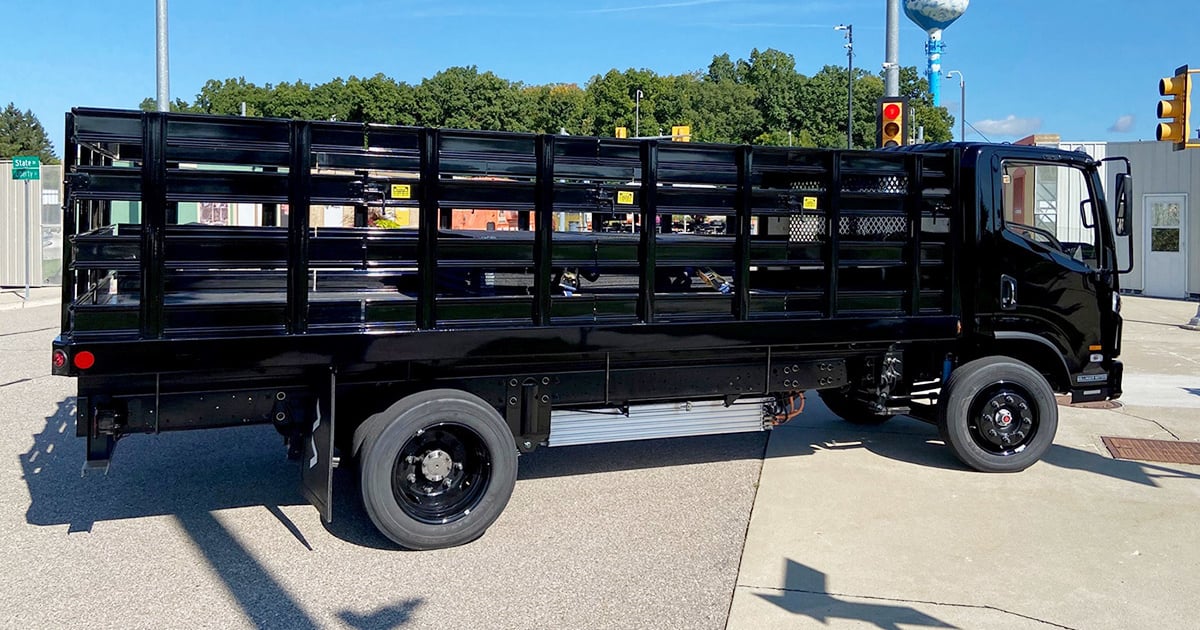
ANN ARBOR, Mich. — Bollinger Motors is about to shift into drive.
With the majority of the engineering complete on Bollinger’s first commercial product, a battery-powered Class 4 chassis cab, final testing is underway. Bollinger’s marketing team is about to hit the road to book orders ahead of the planned start of production in the second quarter of 2024.
“Our next event after we leave here is to take these trucks straight to fleets. We’ll bring them to parking lots and test tracks near customers in whatever state they are in,” CEO Robert Bollinger said.
The company is also building a nationwide dealer network, which will include traditional franchised new-car dealers who also run fleet businesses, said Jim Connelly, Bollinger’s chief revenue officer.
“The order books are open. We have not announced final pricing and we cannot sell directly to customers, but we have customers who have reserved the first ones off the line,” Robert Bollinger said.
For the past 10 days, the Oak Park, Mich.-based startup commercial truck maker has been holding court with potential customers at the University of Michigan’s M City test facility, a series of roads that automakers, suppliers and researchers use to test self-driving vehicles.
The company’s immediate goal is getting noticed in an electric truck market that is getting more crowded by the day. Trucks such as Bollinger’s B4 qualify for the $40,000 rebate in the Biden administration’s Inflation Reduction Act.
Roush Enterprises of Allen Park, Mich., will assemble the B4 under contract. From there, customers will take delivery and have the B4 chassis upfitted. The B4 chassis can be used for numerous vehicles. If demand exceeds Roush’s capacity, more B4s can be made in Mishakawa, Ind., in a former AM General facility owned by Mullen Automotive, which owns 60 percent of Bollinger Motors.
If the B4 doesn’t hit any late snags, Robert Bollinger expects the pivot from startup to revenue-generating company to be complete by next spring when the first deliveries are scheduled to begin.
Dozens of fleet buyers visited M City and test drove five Bollinger B4 trucks upfitted with a variety of bodies. Robert Bollinger would not name the companies that sent representatives to test drive the trucks, but he said last-mile delivery fleets, lawn care businesses and utility companies were among the B4’s potential first customers.
“We’re seeing a lot of interest from utility companies, particularly in California,” he said.
California environmental regulators have launched aggressive mandates requiring fleets to replace combustion vehicles with zero-emission counterparts.
A chassis cab without a body showed the frame, powertrain and suspension and other components. A number of suppliers could be identified, including Dana, which makes the electric rear axle, and Our Next Energy, the Michigan battery manufacturer whose lithium iron phosphate, or LFP, batteries provide power that give the B4 an estimated maximum 200-mile range. Bollinger has the B4’s cab made to its specifications in China.
During several drives around M City in B4s carrying payload, the trucks offered a comfortable ride, adequate acceleration, quiet cruising, strong braking and a very tight turning radius that enables the trucks to make a complete circle in just 44 feet, said Ali Yassine, the engineer who led the development of the chassis. That’s less than many configurations of the smaller Ford F-150 pickup.
Bollinger, he said, started from scratch with the chassis and made the 7-mm-thick frame rails 40 inches apart. That left room on either side of the battery pack to route electrical cables and hydraulic lines inside the frame rails for easy servicing. A few inches of space between the frame rails and the battery pack also could prevent damage to the batteries in a side collision.
The neat and secure packaging of the B4’s power electronics and major systems showed much attention to detail. Robert Bollinger said many of the 75 employees who engineered the B4 have decades of product development experience.
“We have a number of people from Ford and GM and couple of people from Stellantis and we have employees from Tier 1 suppliers,” he said.
While Bollinger buys many off-the-shelf components for the B4, company engineers were responsible for creating the software for the power electronics in addition to the chassis and suspension.
Bollinger not only enters a market with a lot of competition, but also one where sales could be tough — despite hefty incentives.
Class 4 vehicle registrations rose 4 percent through the first half of this year compared with the same period a year earlier, according to S&P Global Mobility. It was among the slowest-growing sectors of the commercial vehicle market.
Vehicle makers saw 21,234 Class 4 truck registrations through the first eight months of this year, according to S&P. Ford was the market leader with a 44 percent share, accounting for 9,240 registrations.
EV Class 4 trucks — all from Canadian startup GreenPower Motor Co. — accounted for only 32 Class 4 truck registrations. However, there is growing demand for electric commercial vehicles of all sizes that will play out over the next several years, according to S&P.

